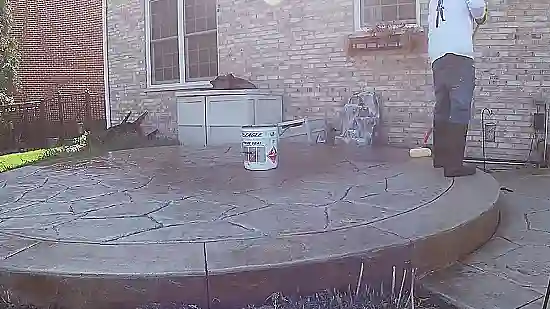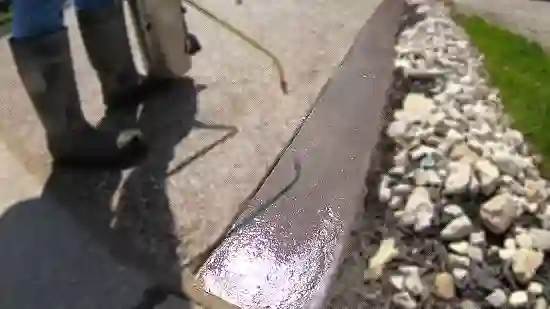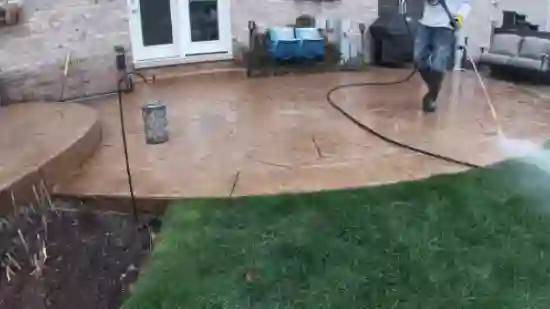If you’ve noticed that your previously clear concrete sealer has turned white, you may be understandably frustrated and confused. But you can take steps to fix this issue and restore your concrete to its original look.
To fix the concrete sealer that has turned white, you must determine the type of sealer you’ve used. Then, remove the sealer from the surface using chemical products like acetone or xylene. After that, apply a new coat of concrete sealer and let it dry completely.
Today we will guide you through fixing the concrete sealer that turned white. We’ll also talk about what causes concrete sealers to turn white. So, let’s see what steps you can take to fix your concrete sealer that turned white.
How to Fix Concrete Sealer Turned White? – Steps to Follow

STEP 1. Determine the Type of Sealer Used
STEP 2. Remove the Old Sealer from the Surface
STEP 3. Apply a New Coat of Concrete Sealer
STEP 4. Let the Sealer Dry Completely
If you have noticed that the concrete sealer you recently applied has turned white, you may wonder what caused this. This is a common issue that can be easily resolved.
Here are some steps to restore your concrete surfaces to their original beauty:
STEP 1. Determine the Type of Sealer Used
To properly address discoloration, you must identify whether you used a water- or solvent-based sealer. A water-based sealer turns white when it comes in contact with moisture. While a solvent-based sealer turns white if applied incorrectly or too much.
If you’re unsure what sealer you used, you can try rubbing a small amount of acetone on the surface. If the sealer dissolves, it’s a solvent-based sealer. If the sealer doesn’t dissolve, it’s a water-based sealer.
STEP 2. Remove the Old Sealer from the Surface
You’ll need to proceed differently depending on whether you have a water-based or solvent-based sealer.
For Water-Based Concrete Sealer
You can restore the original appearance of a water-based sealer by using muriatic acid or mechanical methods. Muriatic acid is a common solution for etching the surface and neutralizing the sealer. Still, following safety guidelines and diluting the acid with water before applying it to the surface is important.
Another option is mechanically removing the sealer by blasting, sanding, or grinding the surface. This method may require more time and effort but can restore the surface to its original appearance.
For Solvent-Based Concrete Sealers
You can remove that pesky white haze from your solvent-based concrete sealer using xylene. Xylene is the go-to solvent for removing sealer on concrete and dissolving the white haze.
You can apply it using a brush or spray, but your best bet is a pump sprayer with an adjustable nozzle. Lightly apply xylene to the white hazy areas on the concrete, let it dry, and mark the area with caution tape until fully dry.
STEP 3. Apply a New Coat of Concrete Sealer
Now it’s time to give your concrete a fresh coat of protection with a brand-new layer of armor specifically designed for your needs. After removing or treating the damaged sealer, you must seal the concrete again to replace the affected portions.
Choose a sealer appropriate to keep your concrete’s protection durable and long-lasting. You should consider the type of concrete surface, its exposure to weather, and the gloss or matte finish you want. Once you’ve selected the right sealer, apply it evenly using a brush, roller, or sprayer.
Follow the manufacturer’s instructions regarding the recommended coverage rate, drying time, and recoat intervals.
STEP 4. Let the Sealer Dry Completely
Make sure to allow the sealer enough time to dry completely before proceeding with the next step. This ensures that your concrete is fully protected and looks its best.
The drying time for concrete sealer varies depending on factors such as the type of sealer, temperature, and humidity. The sealer can take a few hours to a few days to dry completely.
To verify that the sealer is fully dried, check the surface of the concrete for any signs of moisture or stickiness. If the sealer feels tacky or leaves a mark when touched, it’s not ready for the next step.
Why Does a Clear Concrete Sealer Turn White?

If you’re experiencing a clear concrete sealer turning white, it could be due to various reasons.
#1 Inability to Release Water Vapor
Concrete sealers that have turned white are likely due to trapped moisture beneath the coating, resulting in a frosted glass appearance. This is a common issue when using water-based sealers that can’t effectively release water vapor.
The surface crust can form if the temperature is too low or the humidity is too high.
This can trap moisture beneath the coating and causes the sealer to dry in a cloudy or powdery white color.
#2 Sealer Was Applied Too Thick
If you’re still experiencing issues with your concrete sealer turning white, it’s possible that the sealer was applied too thickly. When applied too thick, sealer can trap moisture underneath, preventing it from evaporating properly. This leads to the formation of white, hazy patches on the surface of the concrete.
#3 Rain or Morning Dew
You may have noticed that after rain or on dewy mornings, your once pristine concrete surface has unsightly patches that detract from its beauty. This is because moisture can get trapped between the sealer and the concrete surface, causing a white, cloudy appearance.
#4 Cheap Acrylic Sealer
If you use a cheap acrylic sealer, it’s more likely to turn white over time. This is because cheap acrylic sealers don’t contain enough solids to form a strong bond with the concrete. As a result, moisture can easily get trapped under the sealer, causing it to turn white.
#5 Efflorescence Salts Trapped under Sealer
Have you ever noticed a strange white substance on the surface of your concrete after it’s been sealed? This could be caused by efflorescence salts trapped under the sealer. It can take up to a year to show but can easily be removed with the right technique.
#6 Polymeric Sand Issue
The polymeric sand issue can cause frustration for those looking to achieve a flawless finish on their concrete surfaces. It happens when polymeric sand that fills gaps between pavers or concrete slabs isn’t completely removed before sealer is applied.
When the sealer is applied, it reacts with the remaining polymeric sand, causing the sand to clump together and form white spots on the surface.
What happens if I put too much sealer on the concrete when resealing?
When resealing concrete, over-applying sealer can create unsightly bubbles or blistering on the surface, ruining the overall appearance. This happens when the sealer is applied too heavily, and the air displaced through the surface can’t escape, causing bubbles.
Bubbling can also occur if the concrete is in direct sunlight or if the application is made in hot weather. While this problem is easy to fix, prevention is always better than cure.
If you notice any bubbles forming, wait for the sealer to dry completely, and then use a sharp object such as a scraper or razor blade to pop the bubbles and flatten the surface. Once you’ve done this, you can reapply a thin layer of sealer to restore the surface’s protective properties.
Can I pressure wash off the concrete sealer?

If you want to effortlessly strip off the sealer from your concrete surface, you’ll just need a powerful pressure washer and multiple passes to get it all off. With the right pressure washer, most types of sealers can be easily removed without causing any damage to the concrete.
However, it may take a few passes with the pressure washer for more sturdy sealers to remove it completely. Remember, pressure washing should not be the first option for removing the sealer. You should only consider pressure washing if you’ve already tried other methods that haven’t worked.
Can I use Vinegar to remove the concrete sealer?
Have you ever wondered if vinegar can strip off that stubborn concrete sealer? Unfortunately, vinegar won’t do the trick due to its acid-resistant properties. Most concrete sealants are designed to be resistant to acid, including vinegar.
This means that using vinegar to remove concrete sealer is not viable. Other methods can remove the concrete sealer, such as chemical strippers or mechanical methods like grinding or sanding.
But note that these methods can be time-consuming, messy, and potentially harmful to your health if not done properly. It’s always best to consult a professional if you’re unsure how to safely and effectively remove the concrete sealer.
Fixing White Concrete Sealer: Remove the Old Sealer First
If you notice that your concrete sealer has turned white, it’s not the end of the world. It’s fixable, and the process is relatively simple.
Make sure you know what kind of sealer you’re dealing with, so you can remove it correctly. Be thorough and careful when scraping and cleaning the area, whether you use chemicals or power washers. After you’ve removed the old sealant, apply a fresh coat and let it dry.
Following the above-mentioned steps, you can properly remove the excess sealer and apply a new coat evenly to your concrete surface. Also, applying too much sealer can cause a range of issues.
So, in the future, only apply the recommended amount of sealer and avoid overdoing it. You can confidently maintain and protect your concrete surfaces with your newly acquired knowledge for years.
![How to Fix Concrete Sealer Turned White: Four Steps [DIY]](https://breakingfreemediation.com/wp-content/uploads/2023/06/How-to-Fix-Concrete-Sealer-Turned-White.webp)